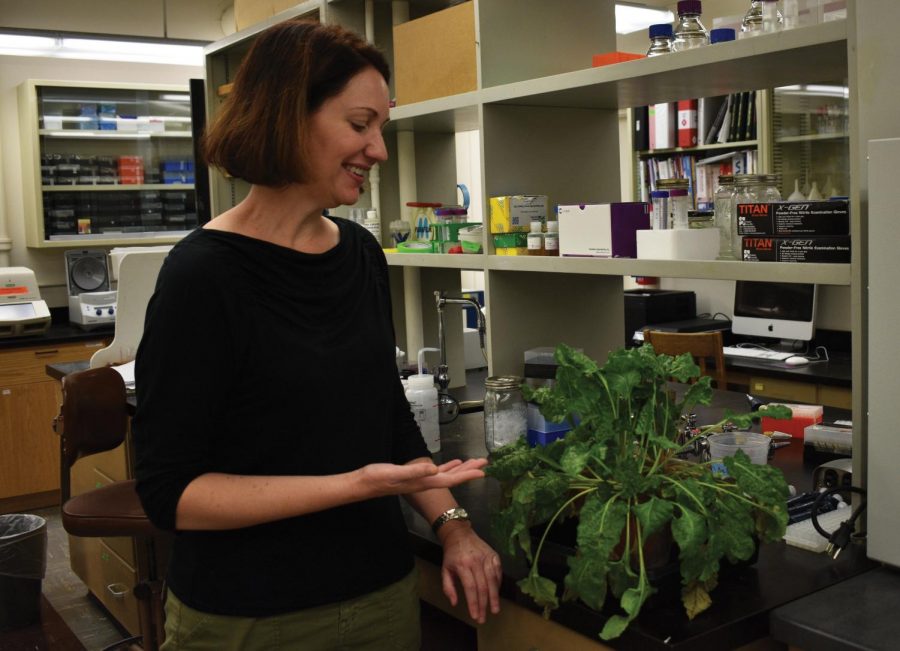Researchers combat costly parasitic worm
Grant will help professors test whether their natural defense to microscopic pests will work for farmers
DYLAN GREENE | THE DAILY EVERGREEN
Cynthia Gleason, an assistant professor in the Department of Plant Pathology, explains how cyst nematodes infected this sugar beet plant in a Johnson Hall research lab Friday. This particular plant will be used as a demonstration in one of her classes.
July 2, 2018
A pair of researchers at WSU are working on a natural-based solution to confront a microscopic pest affecting agriculture across the Northwest.
This pest is a parasitic worm called a root-knot nematode. It can fit on the tip of a pencil and can’t be seen with the naked eye, but Cynthia Gleason, an assistant professor in the Department of Plant Pathology, said don’t let their size fool you.
“They cause billions of dollars in agricultural losses each year,” Gleason said.
Farmers across Washington have seen their crop numbers dwindle due to these nematodes, but Gleason and Jennifer Watts, an associate professor in the School of Molecular Biosciences, have found a way to fight back.
It started when Watts’ research discovered a specific type of fatty acid stopped egg production in Caenorhabditis elegans, or C. elegans, a cousin species of the root-knot nematode.
With the help of a $47,400 grant from the CAHNRS Office of Research, Gleason said she plans on using Watts’ discovery to add genes to plants that will secrete the fatty acid and stop nematodes from reproducing.
“There are fewer and fewer options for growers for combating nematodes,” Gleason said. “Which is why we are looking at new methods, new tools for nematode management.”
Gleason said a majority of the pesticides that have been effective against parasitic worms over the years have been phased out due to their harmfulness to the environment and toxicity to humans.
Pesticides are also very expensive, costing about $350 per acre, Gleason said. But the approach Watts and Gleason are taking is safe for the environment, more affordable and attacks the nematodes right at their source.
Parasitic worms live in the soil as a juvenile and move through it until they find the roots of a crop, Gleason said. The nematode then penetrates the roots and finds its way to the center where it stays and feeds, stealing nutrients and water from the plan.
The nematodes don’t kill the plants, but they wilt them by cutting off their water supply and making them more susceptible to other diseases, Gleason said.
“They’re disrupting the whole process,” she said.
Inside the roots, the parasitic worms feed off plant cells and cause swelling that looks like knots, giving root-knot nematodes their name. This causes crops such as potatoes and carrots to develop lumps making them not ideal for export, ultimately affecting farmers’ yields.
“I mean it’s perfectly safe to eat them, but people don’t want to eat them,” Gleason said about the affected crops.
The researchers plan is to create genetically modified plants containing fatty acids in the roots so when the nematodes feed on them they are unable to reproduce, ultimately wiping out their population, Gleason said.
The grant will help Gleason and Watts test this concept and determine if the fatty acid will affect nematodes ability to produce eggs, Gleason said.
“If that’s the case,” Gleason said, “then we can explore how to implement that in crop plants and what are the effects on plant growth and development.”
Gleason said research has shown that humans can metabolize the natural fatty acid they are going to use, but to be safe they will put it in the roots of the plant.
Currently, Gleason is testing the concept on tomato plants, but she said it can be introduced in all types of crops including grapes, onions, garlic and potatoes in order to defend against the parasitic worms that are having a major impact on agriculture.
Down the road, Gleason said the goal is to give farmers the ability to grow crops that have their own natural pest control.
“We hope that it works beautifully,” she said.










